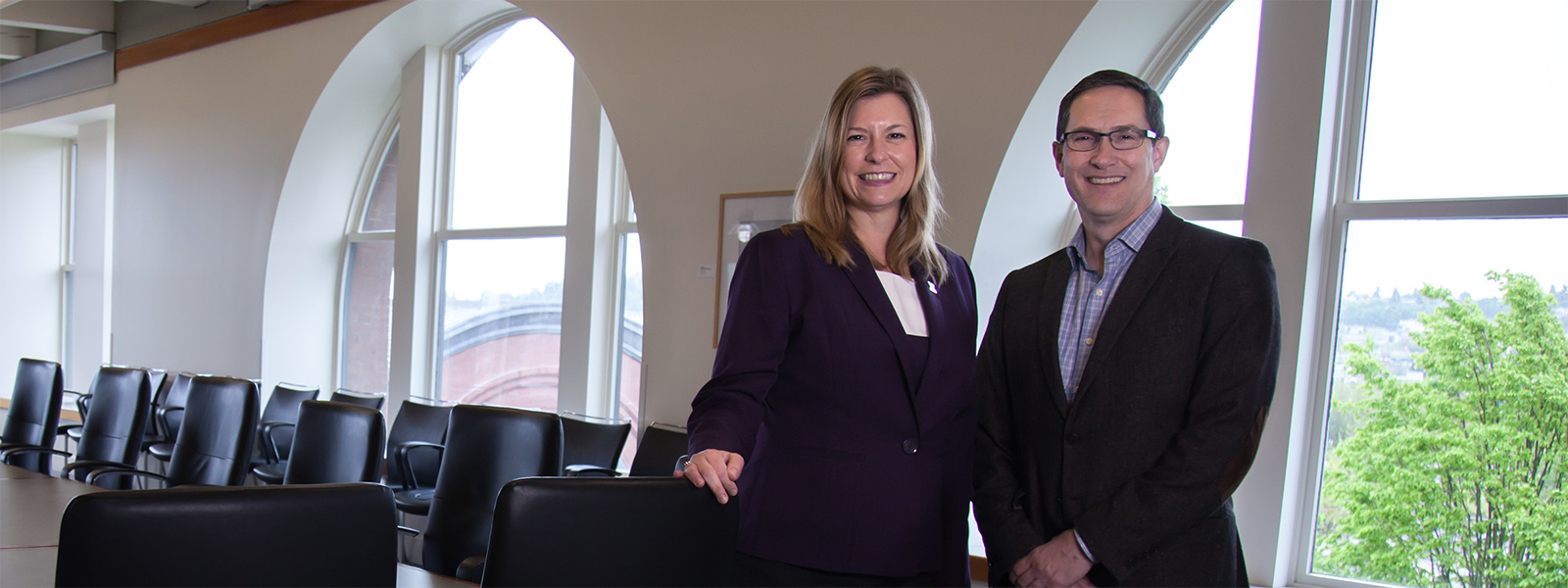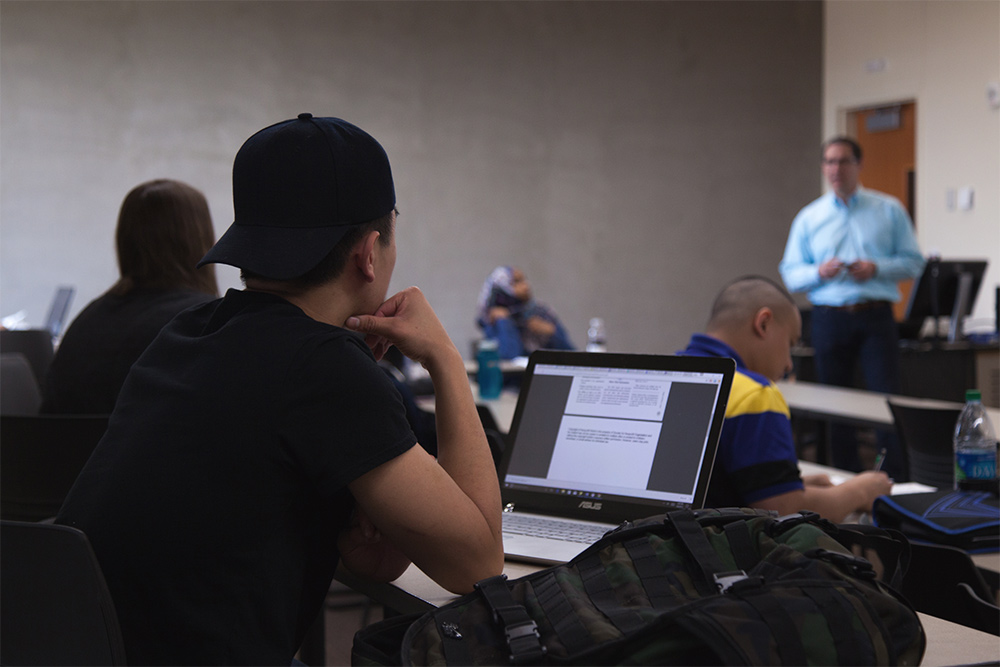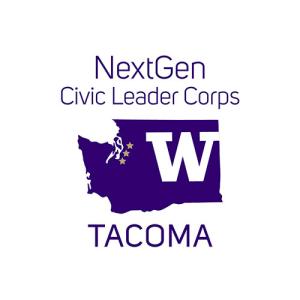
Undergraduates Linking Theory & Practice: Non-Profit Board Governance
Originating in a brief conversation on UW Tacoma's Grand Staircase, a two-course sequence on non-profit governance fosters community connections and helps students achieve their career and service goals.
This is part one of a two-part story on “Board Governance,” a pair of linked courses offered as TMGMT 465 and 466, through the Milgard School of Business. Read part two, “From Classroom to Boardroom.”
Countless conversations happen every day on the Grand Staircase. The sheer volume of social transactions taking place on these steps is immeasurable. Decisions both great and small are mulled over and even made in the time it takes to ascend or descend a set of stairs. Most of these discussions and/or internal monologues are forgotten over time, lost to more pressing concerns or buried underneath layers of memory.
In the haze of everyday, specific moments stand out. Joe Lawless remembers a conversation he had on the Grand Staircase about ten years ago with Associate Professor Jill Purdy (now Associate Vice Chancellor for Undergraduate Affairs). The pair was talking about the world of non-profits, specifically how to get students involved with those agencies’ boards of directors.
The germ of this conversation lies with Lawless and his experience working with Mary Bridge Children’s Hospital. “I was there for about 15 years, seven of those as the executive director of the Mary Bridge Children’s Foundation,” he said. “One question we kept coming back to was how to get younger people involved with our board of directors.”
Lawless left Mary Bridge to pursue his Master of Business Administration degree at UW Tacoma’s Milgard School of Business. He graduated in 2007. Lawless hadn’t been out of school long when the university hired him to lead the newly formed Center for Leadership and Social Responsibility.
This brings us back to the Grand Staircase, Lawless, Purdy and the conundrum of how to get students interested in non-profit board governance. “I suggested we do a class,” said Lawless.
Lawless and Purdy launched an exhaustive search of different academic institutions around the world. They wanted to find a model for their prospective class—none existed. “We didn’t find anything at the undergraduate level that matched our idea,” said Lawless.
With no example to cull from, Lawless and Purdy decided to create their own. The pair enlisted help from a local organization called the Nonprofit Center. The agency has since closed its doors but played a critical role in getting the board governance course off the ground. Among other things, the center helped create a board of community leaders that provides regular input on the course and its objectives.
Lawless and Purdy wanted to create a course that emphasized both the theoretical and the practical. This meant putting undergraduate students in the board room. “Board governance is about everything,” said Lawless. “Big discussions about finance, marketing, leadership and the inner workings of an organization happen during these meetings.”

Letting students see the process in action requires a fair amount of trust. “We had existing relationships with different local organizations and that really helped,” said Purdy. In the beginning only a handful of nonprofits signed up to participate in the course. That number has swelled to include over a hundred different agencies.
Early on Lawless and Purdy decided to spread the Board Governance course out over two quarters, creating a sequence of two classes, TMGMT 465 and TMGMT 466. The rationale is partly due to the fact that boards hold meetings every one to two months. In a standard ten-week quarter students would only get to attend, at most, a few meetings. The other reason for the two-quarter schedule comes back to the emphasis on the practical and the theoretical. “That first quarter [TMGMT 465] is all about becoming a legitimate member of the board and being able to understand and represent that organization,” said Purdy.
In the second quarter [TMGMT 466] students begin piecing together what they’re learning in the classroom and what they’re seeing and hearing in the boardroom. “It’s the perfect blend of the practical, applied knowledge with general theory that can really help students take their learning wherever they want it to go,” said Purdy.
A key element of success is matching students with organizations that fit their interests. The process has been refined over time. Lawless now meets with students individually (Purdy has transitioned into her new role as Associate Vice Chancellor and no longer co-teaches the course) to get a sense of what they care about. “I want to know if they were going to volunteer somewhere would it be for puppies or for cleaning up the waterways or something else,” he said.
The range of nonprofits who have participated in the board governance class reflects the diversity of students at UW Tacoma. Nonprofits of different size and scope have been involved. The list includes: the United Way, Safe Streets, Symphony Tacoma, Centro Latino, Communities in Schools of Tacoma and the Job Carr Cabin Museum. The value of having such variety is reflected in the classroom. “No two organizations are alike in how they make decisions,” said Lawless. “This provides an excellent opportunity for students to learn from each other.”
Lawless advises students to take on the role of anthropologist in board meetings. “I tell them to observe what’s happening and to try to minimize their presence,” he said. However, that’s not always possible. Some groups actively solicit students’ opinions. “Each board has its own culture and some of them are going to want your input,” said Lawless.
The course ends, not with a term paper, but with a presentation. Students prepare a report for their boards about some aspect of the organization. “I tell my students that I don’t know what their final will be,” said Lawless. “I tell them they’re going to get to know their organization, find out what their needs are and work with them to find a topic they need help with.”
At its core, the board governance course is about relationships. Students are afforded an opportunity to interact with local leaders and organizations. “If you think about who sits on the boards of nonprofits, it’s very frequently business executives or people who are highly-engaged in the community,” said Purdy. “The CEO and the student are both serving together on that board.”
Students also get a chance to make connections, an opportunity that is reinforced in the course. Each organization pairs a student with a mentor from the board. This person provides needed guidance that proves useful both in and out of the classroom. “We have a lot of students who’ve been invited to serve on boards as regular members and we have a lot who’ve gotten jobs because of the contacts they’ve made in this course,” said Lawless.
The board governance course is a unique model among institutions of higher education. As a practical matter, the class gives students real-world, hands on experience that will prove valuable later in life. The class also helps nonprofits tap into a younger audience, one with valuable insights that can help an organization better meet its mission. Just think, such a big idea started with a small conversation on the Grand Staircase.



